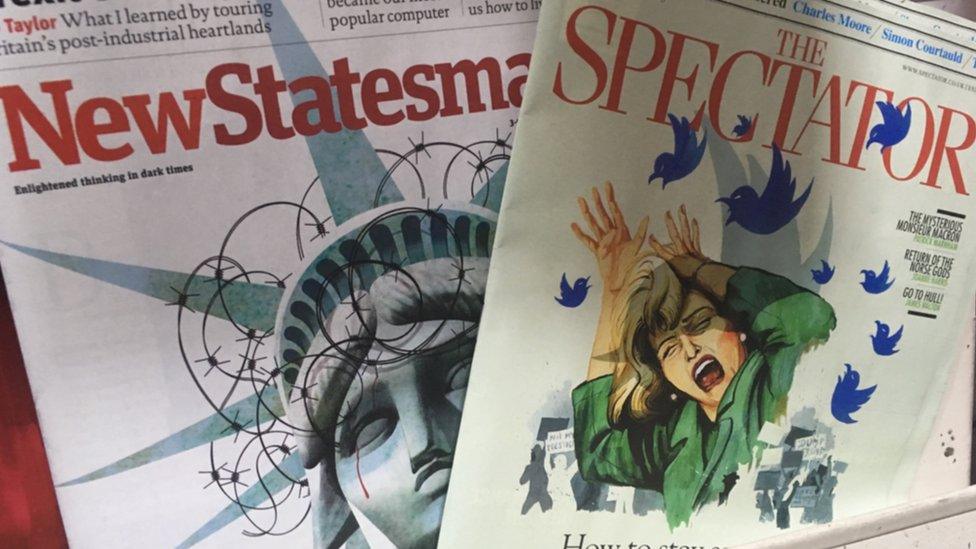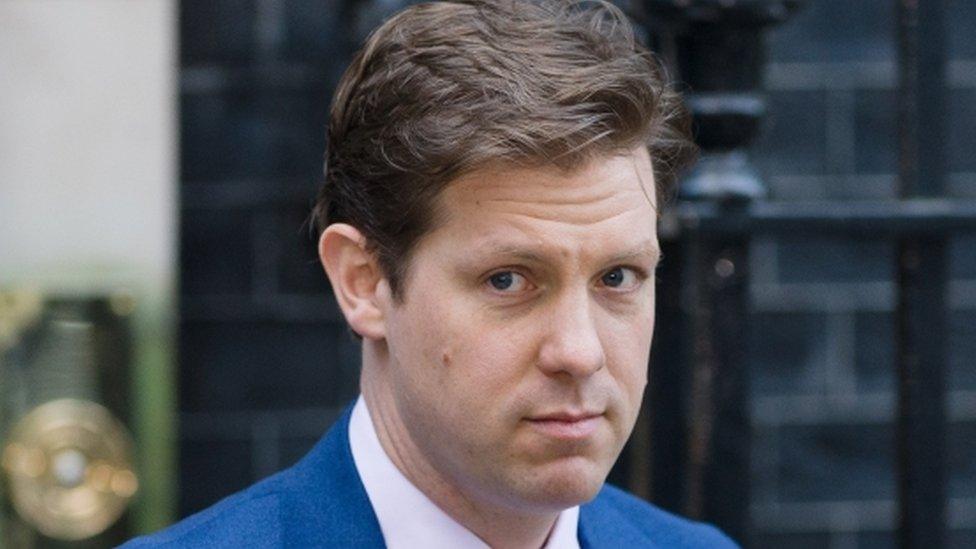Rosy signs for quality journalism market
- Published

So perhaps people will pay for quality journalism after all.
Subscriptions to leading British current affairs magazines, due to be published tomorrow, show a combination of Brexit, Trump and other cultural factors has led to an increase in the number of people handing over money to read smart stuff.
Advance sighting of circulation figures for two leading publications - The Spectator and New Statesman - shows a clear pattern.
For weekly or fortnightly publications that don't do general news, there is a growing willingness to pay for high-quality journalism - whether written, in the magazines, or video and audio online.
This time last year, The Spectator had combined print and digital sales of 62,718, passing a record set in 2006. Of that, 55,165 were print (though print subscribers get access to digital content) and 7,553 were digital only.
Now the combined print and digital figure is 67,120. Of this, 59,923 are print sales, and 7,197 are digital subscribers. In the second half of last year alone, print circulation rose by 3,270.
I pointed out earlier this week Donald Trump has been a boon to the finances of much of the mainstream media - particularly in America. In Britain, Brexit was a more significant factor.
Changing market
Spectator editor Fraser Nelson told me: "Brexit seems to have been the catalyst. News events since then (Trump, etc) have led to a lot more interest in high-quality news and analysis."
Other cultural factors are at play too. This is what really interests me - and Nelson: "The market has changed. There's a lot more acceptance of the idea of paying for films, music and content in general.

Fraser Nelson says Brexit has stimulated interest
"Netflix has helped pave the way for a change in culture. People who would not be seen dead paying for content five years ago are now in the habit of paying for Amazon Prime, music, the odd film and a subscription or two.
"We hear about Trump helping NY Times subscriptions, but I think it's more than that. The market has just turned, and is now welcoming to titles whose brand and quality is strong enough."
There is another factor: "Weirdly, the phenomenon of fake news has also helped emphasise the importance of paying for edited content. Where you get your news from has never mattered more."
Nor is this phenomenon restricted to just one part of the political spectrum. People are paying for high-quality stuff regardless of their leaning.
In his time as editor, Jason Cowley has made the New Statesman much less slavishly left-wing, picking fights with some figures on the left, such as Ed Miliband.
I would say that the Statesman is now a magazine of scepticism rather than leftism. Of course, some of the smartest scepticism originates on the left: Bertrand Russell's Sceptical Essays is among the most important collections published in the 20th Century.
Combined circulation is now 34,025 - of which 32,098 are print and 1,927 are digital - compared with a combined figure of 32,300 this time last year, and 24,000 in 2010. This is a 35-year high.
In 2016 newstatesman.com hit 4 million monthly unique visitors and 27 million monthly page views - close to a 400% increase on 2011.
Cowley told me: "In an era of fake news, people are realising that good journalism is worth spending money on. While much of the liberal media has been struggling to survive in a declining market dominated by powerful media groups, the New Statesman has not merely held its position but expanded dramatically - all achieved… with no marketing spend."
Points to remember
A bright picture - but several caveats are necessary here.
First, I don't yet have the age profile of new subscribers. It would be interesting to know a bit more about this.
Second, many magazines are succumbing to the temptation to bundle print and digital numbers together.
The attempt to conflate numbers is really a way of showing a bit of leg to advertisers. But it is a deliberate misrepresentation of the real picture.
We can hardly take magazines seriously when they call out deceitful public figures if they play fast and loose with their own numbers.
Third, there is a much broader story about web traffic, whether at general newspapers or specialist magazines.
Fourth, the fact people are paying for high-quality magazine content does not mean that this model will necessarily work for newspapers.
The Times, which has a paywall and is growing its subscriber base, has found a business model that works.
The New York Times operates a metered paywall, but it has an editorial budget of over £300m, has a much vaster domestic target market than, say, The Independent and competes with fewer national newspapers in America. It is a curiosity of Britain that we have so many more national titles for our smaller population.
The Financial Times, which also operates a metered paywall, is both a generalist and a specialist publication, because it does so much financial news. It also has the advantage that many of its readers are either rich or, because they work for companies dependent on that financial data, able to buy subscriptions on company expenses.
Advertising squeeze
So it is important not to read across from the success of weekly magazines, which deal in high-quality commentary and analysis, and say the same will necessarily work for daily newspapers.
Their meat and drink is the much more generally available commodity of daily news, and in Britain they compete with the BBC website, whose reach is huge.
Finally, for many publications, the growth in subscriptions will not offset the precipitous decline in display advertising across the market, which is not far off 20% down year on year, as eyeballs migrate to the web.
The Spectator now gets two-thirds of its revenue from paying consumers rather than advertisers. The Economist magazine has argued publicly that it expects display advertising revenue to "pretty much vanish", external by 2025.
The model for print media is being revolutionised. Those dependent solely or mainly on print advertising are in trouble, and will have to diversify their businesses.
Those flaunting a generally available commodity - daily news - will have to do it better, present it more boldly, and manage costs more smartly.
But now we know: those who specialise, and publish regularly but not daily, can ask people to pay, with confidence that they will.
That's good news for journalism.